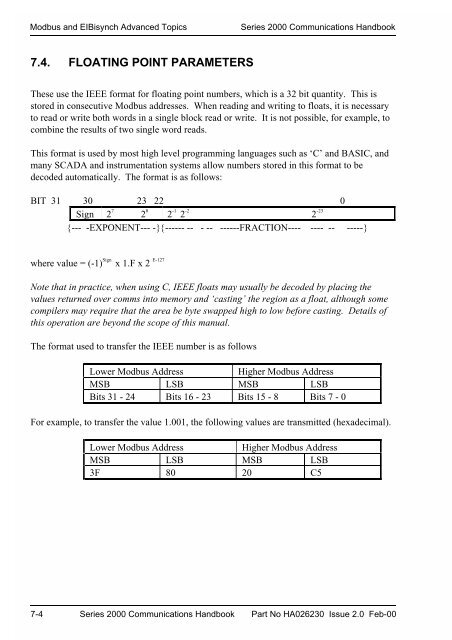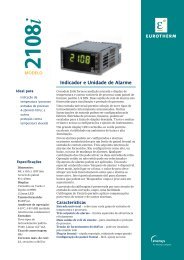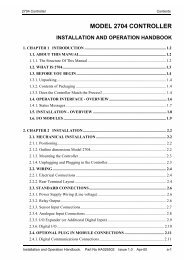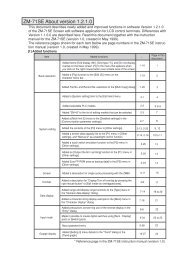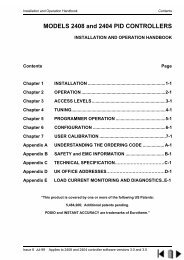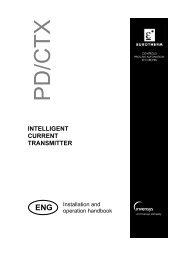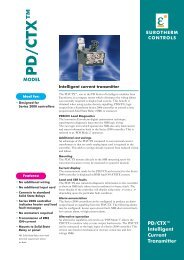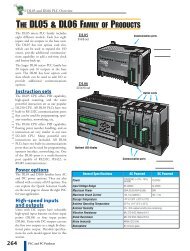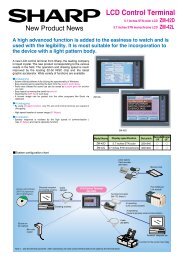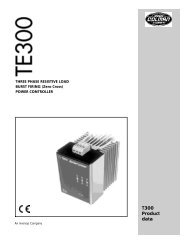- Page 1 and 2:
Series 2000 Communications Handbook
- Page 3 and 4:
Series 2000 Communications Handbook
- Page 5 and 6:
Series 2000 Communications Handbook
- Page 7 and 8:
Series 2000 Communications Handbook
- Page 9 and 10:
Series 2000 Communications Handbook
- Page 11 and 12:
Series 2000 Communications Handbook
- Page 13:
Series 2000 Communications Handbook
- Page 16 and 17:
Digital Communications HardwareSeri
- Page 18 and 19:
Digital Communications HardwareSeri
- Page 20 and 21:
Digital Communications HardwareSeri
- Page 22 and 23:
Digital Communications HardwareSeri
- Page 24 and 25:
Digital Communications HardwareSeri
- Page 26 and 27:
Digital Communications HardwareSeri
- Page 28 and 29:
MODBUS and JBUS ProtocolSeries 2000
- Page 30 and 31:
MODBUS and JBUS ProtocolSeries 2000
- Page 32 and 33:
MODBUS and JBUS ProtocolSeries 2000
- Page 34 and 35:
MODBUS and JBUS ProtocolSeries 2000
- Page 36 and 37:
MODBUS and JBUS ProtocolSeries 2000
- Page 38 and 39:
MODBUS and JBUS ProtocolSeries 2000
- Page 40 and 41:
MODBUS and JBUS ProtocolSeries 2000
- Page 42 and 43:
MODBUS and JBUS ProtocolSeries 2000
- Page 44 and 45:
MODBUS and JBUS ProtocolSeries 2000
- Page 46 and 47:
MODBUS and JBUS ProtocolSeries 2000
- Page 48 and 49:
MODBUS and JBUS ProtocolSeries 2000
- Page 50 and 51:
MODBUS and JBUS ProtocolSeries 2000
- Page 52 and 53:
MODBUS and JBUS ProtocolSeries 2000
- Page 54 and 55:
MODBUS and JBUS ProtocolSeries 2000
- Page 56 and 57:
MODBUS and JBUS ProtocolSeries 2000
- Page 58 and 59:
EI-Bisynch ProtocolSeries 2000 Comm
- Page 60 and 61:
EI-Bisynch ProtocolSeries 2000 Comm
- Page 62 and 63:
EI-Bisynch ProtocolSeries 2000 Comm
- Page 64 and 65:
EI-Bisynch ProtocolSeries 2000 Comm
- Page 66 and 67:
EI-Bisynch ProtocolSeries 2000 Comm
- Page 68 and 69:
EI-Bisynch ProtocolSeries 2000 Comm
- Page 70 and 71:
Modbus & EI Bisynch AddressesSeries
- Page 72 and 73:
Modbus & EI Bisynch AddressesSeries
- Page 74 and 75:
Modbus & EI Bisynch AddressesSeries
- Page 76 and 77:
Modbus & EI Bisynch AddressesSeries
- Page 78 and 79:
Modbus & EI Bisynch AddressesSeries
- Page 80 and 81:
Modbus & EI Bisynch AddressesSeries
- Page 82 and 83:
Modbus & EI Bisynch AddressesSeries
- Page 84 and 85:
Modbus & EI Bisynch AddressesSeries
- Page 86 and 87:
Modbus & EI Bisynch AddressesSeries
- Page 88 and 89:
Modbus & EI Bisynch AddressesSeries
- Page 90 and 91:
Modbus & EI Bisynch AddressesSeries
- Page 92 and 93:
Modbus & EI Bisynch AddressesSeries
- Page 94 and 95:
Modbus & EI Bisynch AddressesSeries
- Page 96 and 97: Modbus & EI Bisynch AddressesSeries
- Page 98 and 99: Modbus & EI Bisynch AddressesSeries
- Page 100 and 101: Modbus & EI Bisynch AddressesSeries
- Page 102 and 103: Modbus & EI Bisynch AddressesSeries
- Page 104 and 105: Modbus & EI Bisynch AddressesSeries
- Page 106 and 107: Modbus & EI Bisynch AddressesSeries
- Page 108 and 109: Modbus & EI Bisynch AddressesSeries
- Page 110 and 111: Modbus & EI Bisynch AddressesSeries
- Page 112 and 113: Modbus & EI Bisynch AddressesSeries
- Page 114 and 115: Modbus & EI Bisynch AddressesSeries
- Page 116 and 117: Modbus & EI Bisynch AddressesSeries
- Page 118 and 119: Modbus & EI Bisynch AddressesSeries
- Page 120 and 121: Modbus & EI Bisynch AddressesSeries
- Page 122 and 123: Modbus & EI Bisynch AddressesSeries
- Page 124 and 125: Modbus & EI Bisynch AddressesSeries
- Page 126 and 127: Modbus & EI Bisynch AddressesSeries
- Page 128 and 129: Modbus & EI Bisynch AddressesSeries
- Page 130 and 131: DevicenetSeries 2000 Communications
- Page 132 and 133: DevicenetSeries 2000 Communications
- Page 134 and 135: DevicenetSeries 2000 Communications
- Page 136 and 137: DevicenetSeries 2000 Communications
- Page 138 and 139: DevicenetSeries 2000 Communications
- Page 140 and 141: DevicenetSeries 2000 Communications
- Page 142 and 143: DevicenetSeries 2000 Communications
- Page 144 and 145: Modbus and EIBisynch Advanced Topic
- Page 148 and 149: Modbus and EIBisynch Advanced Topic
- Page 150 and 151: Modbus and EIBisynch Advanced Topic
- Page 152 and 153: Modbus and EIBisynch Advanced Topic
- Page 154 and 155: Glossary of TermsSeries 2000 Commun
- Page 156: ASCII CodesSeries 2000 Communicatio


